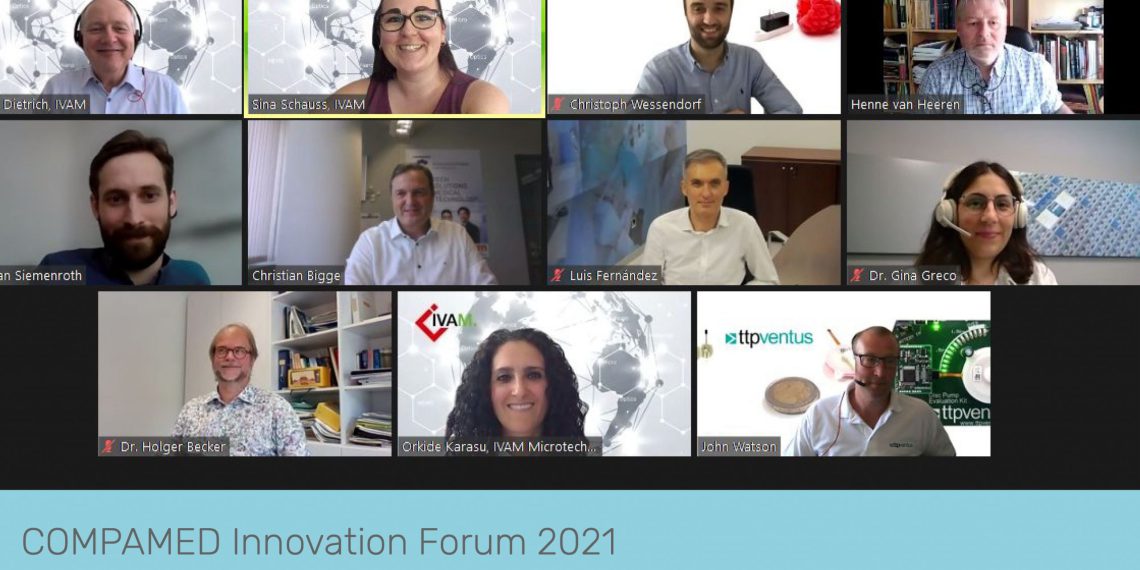This year, the COMPAMED Innovation Forum with international participation was dedicated to the topic complex “Microfluidics for mobile diagnostics and development of vaccines and drugs” and presented how microfluidic processes can help, for example, to solve the red-hot challenges of a global pandemic better and faster in the future.
The digital forum brought more than 120 interested parties and speakers into dialogue with each other during a webinar and later networking. The corona pandemic is a current reminder of the importance of high-tech innovation in driving research and development quickly and effectively. The development of the new vaccines now available in the fight against COVID-19 could also be implemented at record speed because of these innovative processes.
Dr. Holger Becker from microfluidic ChipShop explained that microfluidics also plays a decisive role in currently sought-after molecular biological test methods such as PCR, antigen and antibody tests, and that it has the potential to offer decisive time advantages in terms of development speed.
Microfluidic elements and structures offer enormous advantages in the production of diagnostic products
Luis Fernández of Spain-based microLIQUID is a specialist in custom microfluidic elements and emphasized that these devices offer many advantages in development processes because they are inexpensive, lend themselves to high throughput and automation, and offer improved sensitivity.
Dr. Alexios Paul Tzannis, of IMT Masks and Divisions from Switzerland explained challenges and opportunities of functional surfaces, e.g. for biosensors in microfluidic flow cells for diagnostics. Particularly promising is the combination of glass and a complex structure on or in the glass combined with new methods, which allows the production of new consumables for diagnostics and life sciences, as well as scalable volume manufacturing.
Jacques Pechdimaljian of France’s Fluigent added that there is a large market for microfluidic products: from life science research to clinical research in human and veterinary medicine to industrial research, especially for point-of-care and point-of-use applications such as rapid testing.
John Watson of U.K.-based pump manufacturer TTP Ventus explained how users should select the right pump for a compact and mobile POC diagnostic system. The company’s particularly compact disc pump, for example, is suitable for use in mobile PCR diagnostic instruments, the “gold standard” of diagnostics.
Key technologies enable accelerated development and optimized distribution of vaccines
How can the current problem of insufficient vaccine availability be solved, especially in light of the fact that the first “boosters” will soon be necessary? Christoph Wessendorf of memetis and Florian Siemenroth of Bartels Mikrotechnik are working together on solutions for miniaturizing active flow control to enable higher sensitivity and high specificity in test measurements, such as antibody status. Microfluidics could thus help determine individually when follow-up vaccination is needed to most efficiently distribute scarce MRNA vaccines.
Dr. Gina Greco of Swiss sensor manufacturer Sensirion explained the role of innovative sensors that, in concert with microfluidics, provide the key technology that enables vaccines and other drugs to be developed within a year. For example, by detecting air bubbles in the system, a flow sensor ensures stabilized and pulsation-free flow. Continuous optimization of laboratory equipment therefore offers enormous potential for fast and reliable test results in drug and vaccine development.
The COMPAMED Innovation Forum series of events is organized by the IVAM Microtechnology Association and Messe Düsseldorf and addresses current medical technology challenges once a year. The dialog between experts sheds light on innovations and provides an outlook on trend topics in the event series, which takes place annually in the fall in Düsseldorf.

















